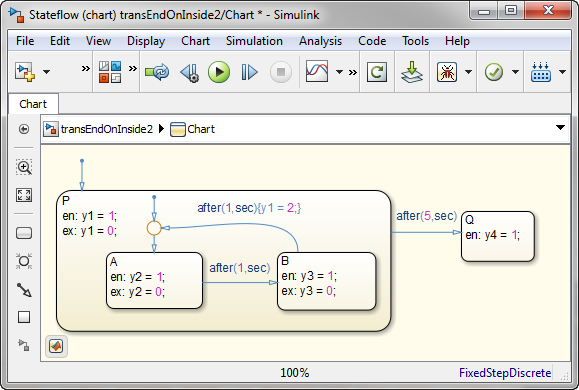Stateflow Semantics: Shortcut to Default
Today I want to share with you one of the lesser known semantics of Stateflow: the transition that ends on an inner boundary of a state.

This is not an inner transition; those start on an inner boundary, not end on one. Rather, these transitions serve as shortcuts back to the default transition path.
Get Back
Here we have a small example, with a state P that has two children, A and B, and four outputs to help us understand what's going on.
- When the chart is first entered, the top-level default transition directs Stateflow to enter state P. The entry action for that state sets y1 = 1.
- Stateflow then looks for children of P; finding none already active, it follows the default transition inside P to child A.
- Now A's entry action sets y2 = 1 as well.
- At time = 1 second, the transition to B is valid. During that same timestep, Stateflow sets both y2 = 0 and y3 = 1.
- At time = 2 seconds, the transition going out from B is now valid. Stateflow sets y1 = 2, then y3 = 0 as B is exiting.
- From there, Stateflow jumps back up to the default transition that leads to A, and does the entry action for A again, setting y2 = 1, all in the same timestep.

And we can look at the outputs on a Scope:

In effect, this transition has served as a shortcut to the default transition path of the parent, P. Notice from the screenshot of the Scope above that parent P is not exited and re-entered at time = 2 seconds; y1 = 2 until P is exited for Q at time = 5 seconds.
We could obtain the same result by using a junction on the default path (below), but that can get messy visually, especially if you have a large parent state with many children.

Now it's your turn
Do you have a really interesting application for this Stateflow semantic? Share it in the comments below!
- Category:
- Stateflow
 Cleve’s Corner: Cleve Moler on Mathematics and Computing
Cleve’s Corner: Cleve Moler on Mathematics and Computing The MATLAB Blog
The MATLAB Blog Guy on Simulink
Guy on Simulink MATLAB Community
MATLAB Community Artificial Intelligence
Artificial Intelligence Developer Zone
Developer Zone Stuart’s MATLAB Videos
Stuart’s MATLAB Videos Behind the Headlines
Behind the Headlines File Exchange Pick of the Week
File Exchange Pick of the Week Hans on IoT
Hans on IoT Student Lounge
Student Lounge MATLAB ユーザーコミュニティー
MATLAB ユーザーコミュニティー Startups, Accelerators, & Entrepreneurs
Startups, Accelerators, & Entrepreneurs Autonomous Systems
Autonomous Systems Quantitative Finance
Quantitative Finance MATLAB Graphics and App Building
MATLAB Graphics and App Building








Comments
To leave a comment, please click here to sign in to your MathWorks Account or create a new one.